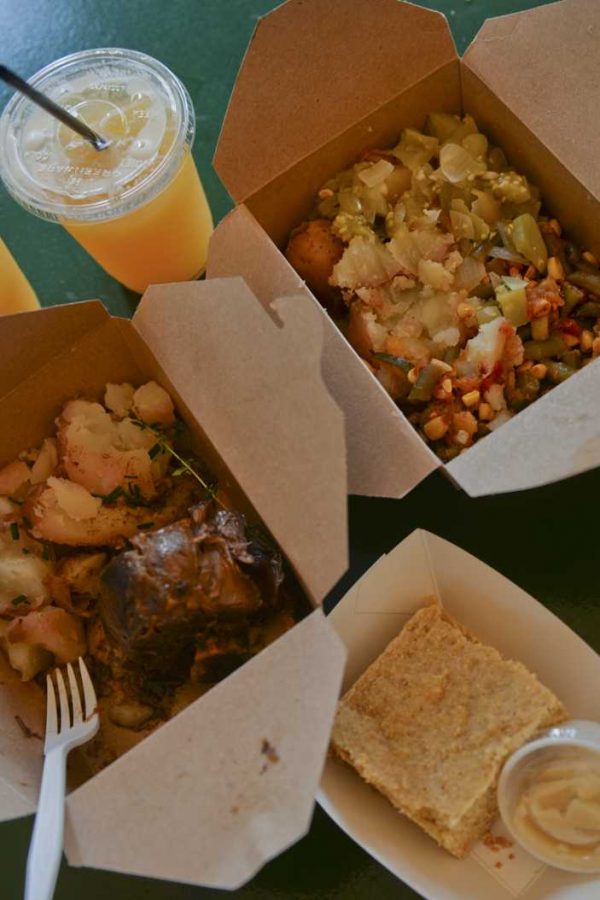After offering cuisine based on contemporary conflicts between countries around the world and the United States, Conflict Kitchen turned this spring to a domestic feud: Native Americans and their cultural erasure within modern society.
The current featured region — which will run through the spring with seasonal changes — is in upstate New York: the Haudenosaunee Confederacy, otherwise known as the Iroquois Confederacy, a league of six indigenous nations.
Although the United States hasn’t been in a physical conflict with the Haudenosaunee Confederacy since the American Revolution, the confederacy is still awaiting Congress to reinstate its revoked tribal status. Conflict Kitchen’s aim is to offer Haudenosaunee perspectives on economic and environmental conflict and indigenous sovereignty.
Conflict Kitchen changes its cultural region every couple of months. For the new region, the Schenley Plaza takeaway venue also switched up the posters in the windows to a blue-and-yellow diamond design on a burgundy background.
Outside the pickup window, there’s a short video playing a recap of Indigenous Peoples’ Day 2015, when Haudenosaunee people visited Conflict Kitchen. They taught the restaurant how to cook a native white corn soup — and the special offerings Conflict Kitchen featured that day inspired its current menu. Behind the counter, there’s also educational handouts — one explains how hair is an expression of cultural identity in Haudenosaunee culture, and another describes Indigenous Peoples’ Day’s aim to challenge racism and Columbus Day.
After mulling over the one-page menu of cranberry and juniper braised venison — called Neogë’ Wade’sgöndak — and drop dumplings boiled with fruit — O’Hösda’ Onyögwi’sä — we sought out what sounded the most unfamiliar to us. Lexi opted for two small dishes: the succotash and the cornbread, while Caroline decided on the quail and the seasonal wild fruit drink.
Lexi’s succotash, Ogösäse, features sweet corn, beans and squash stewed with tomatoes and peppers. At first glance, the vibrant red of the soupy tomato base contrasted well with the yellow of the sweet corn and the green of the peppers and beans. The succotash’s base was savory with a hint of sweet, reminiscent of a minestrone-style soup. The green beans were crunchy, juxtaposing well with the melty softness of the squash, stewed tomatoes and peppers. Overall, the dish was mildly seasoned, but not a disappointment.
Gagaihdëhdö, the official Haudenosaunee name for cornbread, was crafted from roasted Iroquois white corn flour and was crumbly and surprisingly sweet. Though anticipated, the graininess was a welcome texture that prompted nostalgia for a home-cooked meal. In appearance, the common-looking square of bread plopped onto a paper takeout dish was nothing special, but the taste and texture certainly were.
As Caroline unfolded the top flap of her brown cardboard takeout box, the rich aroma of an elegantly portioned, Iroquois-inspired meal rushed out. The brown container was warm, neatly packed with three simple dishes combined, listed on the menu as Johngwe’yoni. Inside, a grilled quail sat atop a bed of mixed greens and boiled red potatoes, all lightly seasoned and simple in terms of presentation.
The quail was served whole, a somewhat unsettling visual resembling a miniature rotisserie chicken. It was prepared grilled, supplying it with a smoky flavor that offset the tangy vinaigrette coating of the mixed green salad. Boiled potatoes provided the perfect buffer between the tastes of the other two dishes: smooth, buttery and salty in just the right amounts.
The seasonal wild fruit drink, which tasted naturally sugary, was a welcome change from the artificially flavored beverages served at popular eateries elsewhere. The deep purple mixture paired nicely with the rest of the meal. Though simplistic in nature, the meal had a complex range of flavors that otherwise would have been smothered by additional seasoning or sauces.
Although the dishes of the Haudenosaunee cuisine aren’t too far off from traditional American fare, the fine-tuned flavors and simplicity of the preparation are definitely worth trying.
If you’re seeking out a meal reminiscent of your mother’s cooking, but also crave an adventure, trying food from a different North American culture will be a pleasant surprise.


